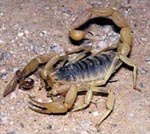|
All Wild Animals Can Be Dangerous
 Human conflicts with bears, cougars and alligators usually receive widespread media attention. However, most conflicts that result in human injury involve other species of wild animals. Conflicts with wildlife are primarily caused by inappropriate human behavior. Human conflicts with bears, cougars and alligators usually receive widespread media attention. However, most conflicts that result in human injury involve other species of wild animals. Conflicts with wildlife are primarily caused by inappropriate human behavior.
- Many wildland visitors mistakenly believe that there are specific gestures and warning signals wild animals make that will give people time to retreat to safety. Wild animals (including bears, deer, elk, alligators, wild hogs, squirrels and raccoons) are individualistic and unpredictable. Animals that ignore you, look calm, or apprear friendly may suddenly and without warning charge or strike out.
- Human injury often occurs when any animal responds to a perceived threat with instinctive “fight or flight behavior”. People get injured simply because they are too close and in the animals way. A car horn, barking dog or excited child can trigger an animal into a fight or flight behavior.
- Both females and males of most species are equally dangerous.
- Although animals may look or act tame, they are wild and may change quickly and unpredictably from passive or “friendly” to aggressive behavior.
- If an animal approaches you, it is your responsibility to move away to maintain a safe distance.
Wildlife Field Notes
Deer, Elk and Moose
 May charge and attack humans who approach them. May charge and attack humans who approach them.
- Are often mistakenly believed to be tame like Bambi.
- Can Kill People by rearing up and striking with their front hooves.
Bison (Buffalo)
- Weigh up to 2,000 pounds and run up to 35 mph, faster than Olympic sprinters!
- May look tame while standing or grazing quetly, but frequently charge humans without warning.
- Have killed people by goring them.
- Vigorously protect their young.
 Chipmunks, Squirrels, Rabbits and Marmots Chipmunks, Squirrels, Rabbits and Marmots
- Have plenty to eat and should not be fed peanuts or other food.
- Have bitten and scratched people who have tried to feed them.
- May have rabies or hantavirus.
- Carry ticks that cause Lyme disease or Rocky Mountain Spotted Fever.
 Coyotes, Raccons and Foxes Coyotes, Raccons and Foxes
- Are not tame, even through they may approach people and appear friendly.
- They may also carry rabies.
- Most are active mainly at night.
Mountain Goats and Bighorn Sheep
 Have butted, kicked and gored people who approached them. Have butted, kicked and gored people who approached them.
- Have become aggressive towards people after being fed.
Spiders, Scorpions and Ticks
- Can crawl into your shoes, bedding or clothing. Shake out clothes and bedding before you get into them.
 Will hide in rocks, bushy areas and in firewood. Watch where you put your hands and feet. Will hide in rocks, bushy areas and in firewood. Watch where you put your hands and feet.
- May not be felt at first. Check yourself and children closely each night for ticks and bites.
|